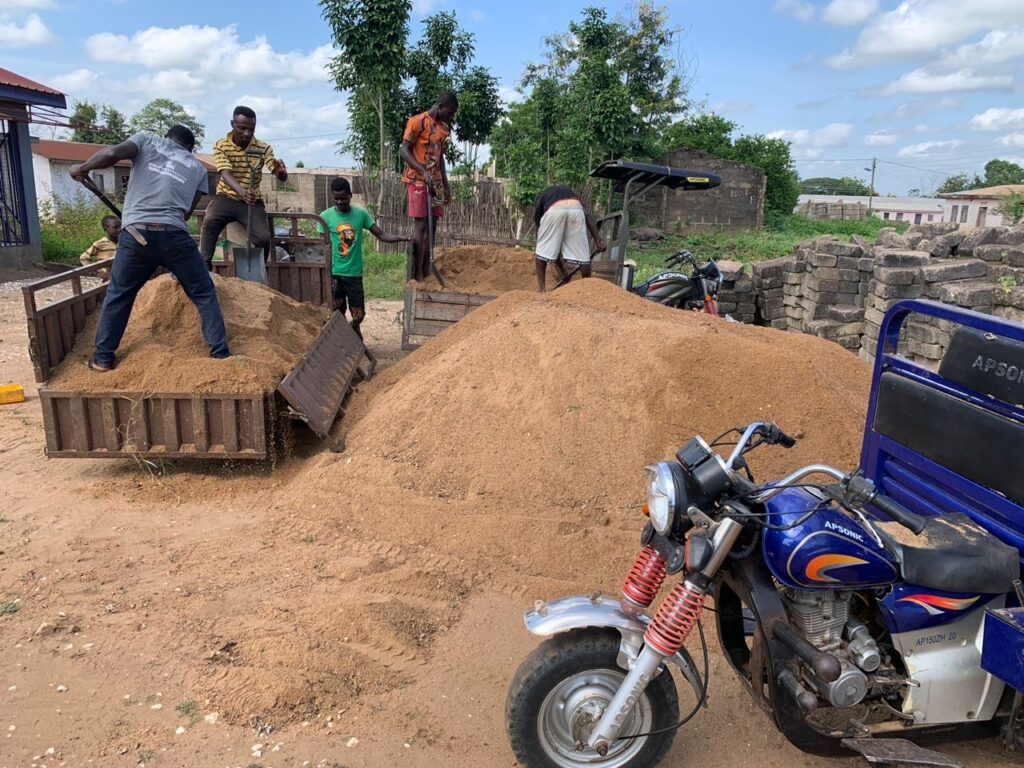At Community Action Ghana we pride ourselves on working with communities to fulfil their needs, in the ways they want them – the communities’ priorities our priorities.
In 2019 we worked with the community of Alavanyo Dzogbedze to build a sustainable, community toilet. We are delighted to report that a recent survey found that 326 people are using the toilets.
At the communities’ request we worked together to build a Kumasi Ventilated Improved Pit (KVIP) toilet block. This is a well know toilet system in Ghana, developed locally at Kumasi Institute of Technology (now the Kwame Nkrumah University of Science and Technology).

The sustainability aspect of these toilets is what was so important to us all. To show this, we’ll explain a little bit about how they work. The most important part of these toilets is the pit or the holding tanks. All the toilet deposits go into these tanks. They are designed to be very well ventilated so no, or little, smell goes back up into the cubicles. Any flies that follow their noses onto the poo are cunningly trapped in the tank until they die. If the flies could escape, they would carry germs on their legs and bodies, leading to fly borne diseases. With the KVIP model they can’t escape so this stops them spreading diseases.
In each toilet cubicle there are two squatting plates, and two toilet seats in the accessible cubicles. However, only one is opened initially, the other is sealed shut with a strong layer of concrete. Each tank is designed to hold about ten years, worth of deposits. The theory is, in ten years’ time when it is full, the initial plate will be sealed and the second chipped open to start filling the neighbouring holding tank. After about 20 years the contents of the first tank will have thoroughly composted killing any pathogens. This holding tank is then emptied, and the process starts again.
This sounds like a wonderfully, sustainable build designed to last decades.
However, when checking the toilets in Alavanyo Dzogbedze this month, we found that after just four years the initial tanks on the female side were full. And there was a smell coming from the toilets, which understandably those living closest to them were disturbed by. There was also rather an abundance of flies coming out of the toilets.
What was the problem?
The female toilets are in such demand, and so well used, that instead of the ten years expected to fill them, they have been filled in just four years. We see this as a good thing, illustrating the huge different these toilets are making, especially for the female members of the community, who use them the most. We sealed the first full tank and opened up the second empty tank so the ladies will start using an empty tank.We will keep monitoring the usage and report back, when the second tanks are full – to see if the first tank has composted thoroughly enough to destroy the pathogens and reopen to continue the substantiality of the toilets.
What about the smell.
Sealing off the full holding tanks and opening the empty holding tanks should alleviate the smell problem as the smell was coming from the full tanks. We also went round the holding tanks and used mortar to seal any cracks and crevices that allowed smells to escape. After we had done this there was an immediate clearing of the air. We will continue to monitor the situation.


What about the flies?
The solution to this is simple, the toilets were designed so any flies that were attracted to the smell of the faeces would be trapped in the holding pits – unable to fly away to transmit diseases. However, even after educating the toilet users about the importance of closing the toilet doors to allow this process to take place, flies were still getting out – creating the possibility of disease. Our solution – attaching springs to the toilet doors to ensure they remain closed after use. Again, we will report back to check that this has continued to prevent fly borne diseases.

We are currently fundraising for another toilet block in Dorfor Adidome. Due to the terrain and location of the toilets they have requested a water based toilet system, so we will ensure these are as sustainable as possible and continue to learn and adjust when needed. The water tank system is more expensive than the KVIP’s and inflation in Ghana is dramatically affecting our budgets, so if you are able, we would really appreciate your support to ensure we can help another community live with toilets and combat disease.
![]()












